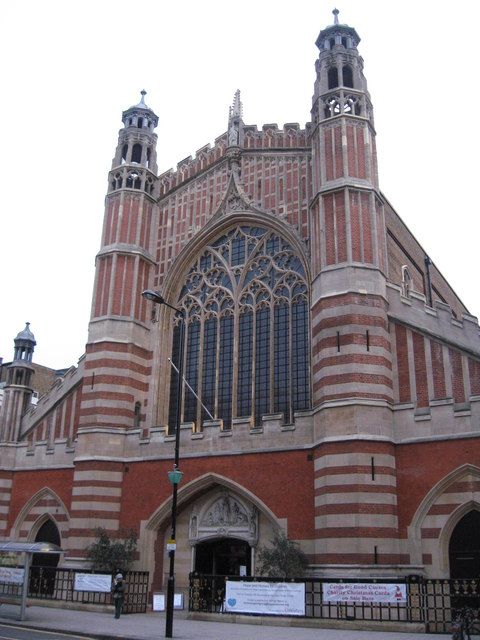THE STATION: Sloane Square

The heart of rich and trendy London: Sloane Square has long been a “buzzing” and “happening” place. It’s station received a direct hit on during a busy rush hour in November 1940, killing 36 and injuring 79, as well as causing very severe destruction.

It was first opened on Christmas eve 1868, by the Metropolitan District Railway and it’s construction was greatly complicated by the Westbourne river which runs through it (it goes through an iron conduit, suspended from the roof): surely this is the only building in London where this is the case?
Sloane Square boasts much that is “hip & happening place” in terms of culture: including many fine bars and restaurants, as well as the famous Cadogan Hall. It also boasts two of the most significant churches in London, these are St. Mary’s Bourne Street, and Holy Trinity Sloane Street. It would be foolish for us to be in the area and to not call in at both, so we shall.
St Mary’s Bourne Street

There are several churches, especially in London, which always cause a thrill of excitement among true Anglo-Catholics: St. Magnus the Martyr, London Bridge; St. Silas the Martyr, Kentish Town; The Annunciation, Marble Arch (the most beautiful church in London) to name a few, but few cause more of a thrill than St. Mary’s, Bourne Street (libretto by Cranmer, choreography by the Congregation of Rites). It is not an easy church to find: it is tucked away down Bourne Street, set back from the road, the porch being an octagonal tower, which is always open, even if the church is locked, and one may peer through the window and catch a glimpse at the delights within.
There is little we can say which is not summed up perfectly in the Collins Guide to English Parish Churches (The Southern volume), edited by Sir. John Betjeman, and so we will leave it at that, and suggest a perusal of their website (as indeed we strongly encourage a perusal of all the links on these posts, that you may read, mark, learn & inwardly digest):
St. Mary’s, Bourne Street
By R. J. Withers, 1874. Small and stately apsidal-ended brick mission church, with 1920-ish Baroque fittings by Martin Travers, and N. chapel by H. S. Goodhart-Rendel. The Society of SS. Peter and Paul’s model church. Once one of London’s smartest churches, Ronald Firbank worshipped here before his conversion to Rome.

Holy Trinity Sloane Street

Crossing the square, and turning the corner onto Sloane Street, there appears on our right the rather more obvious frontage of Holy Trinity: every bit as important as Bourne Street, but very, very different. In its hey day, the first vicar, The Rev’d Henry Blunt used to pack ‘em in from miles around to hear his great orations.

The east window
On entering, we are confronted with some of Burne-Jones’ finest glass and we see the three bases of font, altar and pulpit strongly emphasised in the architecture of the place. Betjeman describes it in the Guide to Parish Churches as being “The Cathedral of the Arts & Crafts movement”, which it most surely is. We will leave here with a bit more of the man who must surely be credited with the accolade of having saved this church:
MCMVII
Light six white tapers with the Flame of Art,
Send incense wreathing to the lily flowers,
And, with your cool hands white,
Swing the warm censer round my bruised heart,
Drop, dover-grey eyes, your penitential showers
On this pale acolyte.
The tall red house soars upward to the stars,
The doors are chased with sardonyx and gold,
And in the long white room
Thin drapery draws backward to unfold
Cadogan Square between the window-bars
And Whistler’s mother knitting in the gloom.
How many hearts turn Motherwards to-day?
(Red roses faint not in your twining stems!)
Bronze triptych doors unswing!
Wait, restive heart, wait rounded lips to pray,
Mid beaten copper interest with gems
Behold! Behold! your King!
THE PLACE: Peter Jones
And since we are in that part of the world, we really must call in, very briefly, to the centre of all that is lovely and wonderful, which doesn’t come from Fortnum’s: Peter Jones.

Peter Jones
And having made it so far, it’s high time we had a bit of a sit down and took refreshment, and where else than where the Chelsea Pensioners go for a swift one? It is an oasis of normality among the trendiness.

